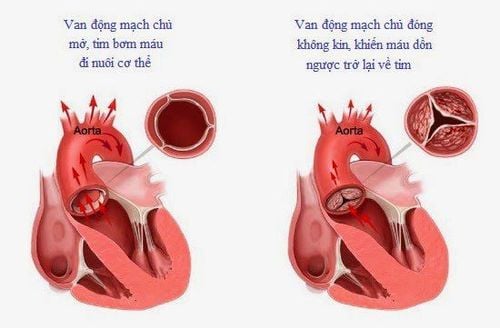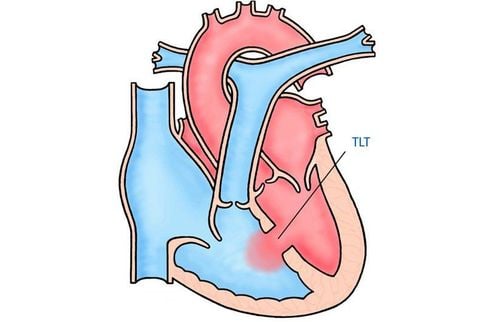This is an automatically translated article.
Left ventricular aortic bypass surgery is a surgical treatment applied on patients with complex congenital heart disease. This is a modern and very complex technique, requiring doctors with deep expertise and experience in the process of performing this technique.
1. What is congenital heart?
Congenital heart disease is a disease related to the heart that newborns have at birth, there are many clinical forms that patients can have. In order to treat a congenital heart, the patient needs to undergo some necessary cardiovascular surgery to correct the damage in the heart. For infective endocarditis, which is an infection of the heart valves, then spreads to surrounding sites and the interventricular septum is a very difficult pathology to operate because of the anatomical structure in this position. This position is very complex, so it is necessary to perform special surgical methods to treat this pathology.
Or for some other diseases such as aortic inflammation leading to dangerous conditions such as aortic valve regurgitation, having to undergo valve replacement surgery or aortic valve repair many times but still not treated. success.
The above-mentioned inflammation of the aorta is caused by many causes and once the valve is replaced, the possibility that the patient will have aortic valve rupture is very high, so it is necessary to conduct treatment with the following methods: other more suitable. Aortic-left ventricular apex shunt is considered a successful surgical treatment for aortic dissection, as well as infective endocarditis, which can also be treated with endocarditis. this method.
Recommended video:
Signs that your child has a congenital heart defect, you need to see a doctor right away
2. Left ventricular aortic apex shunt

Nối tắt mỏm thất trái- động mạch chủ thường được thực hiện với những bệnh nhân có gốc động mạch chủ bị vôi hóa
Left ventricular aortic bypass is a surgical method to establish a bypass between the left ventricular apex and aorta. This is a method that has been studied a lot in the world and gives quite positive treatment results for some congenital heart diseases. This method is performed by conducting blood drainage starting from the chamber of the left ventricle to the position of the inferior aorta, this stage is done through the use of an artificial vessel with a valve in the middle of the tube. .
However, left ventricular aortic anastomosis is not an approach that can be applied to all cases of cardiovascular disease and is usually performed only in patients with calcified aortic root. become more fragile, become thinner and more fragile. If the above method is applied in cases that are not recommended, it can cause some dangerous complications such as dilatation of the right ventricle, the phenomenon of coronary artery bypass right below the sternum causing severe sternum infection. For severe congenital heart diseases such as left ventricular outflow tract stenosis, when creating a bridge between the left ventricular apex and the aorta, it can cause severe stenosis of the aortic valve, affecting the functioning of the aortic valve. and properties of the heart.
The method of left ventricular aortic anastomosis has many advantages over other treatment methods, namely:

Nếu điều trị bệnh viêm động mạch chủ bằng phương pháp thay van tim nhân tạo thì sẽ có khả năng bị bong van nhân tạo
For infective endocarditis: If the patient uses partial or complete resection of infected tissues, the possibility of the left ventricular outflow tract will not be preserved, leading to the replacement of the artificial valve for the patient. The patient encountered many difficulties because the specific location could not be determined because the left ventricular outflow tract was destroyed during the resection. In addition, in the state of the endocardium of the heart is infected, the myocardial tissue will be edematous, so suturing the heart valve will be very difficult, if done, there is also a risk of suture rupture. For the above reasons, performing aortic root closure and simultaneously performing bypass between the left ventricular process and the aorta would be an optimal and more feasible choice. For patients with aortic inflammation: Aortic inflammation, if treated by prosthetic valve replacement, in most cases, after surgery, the patient will have a prosthetic valve detachment, possibly an aneurysm. at the stitch position. This condition is explained by the aortic wall as well as the tissue in the heart valve ring not well controlled during aortic inflammation. In addition, after surgery, the thread will also burst due to the inflammatory valve ring leading to the valve edge being opened a lot. At this time, if the surgery is performed again to continue to replace the heart valve, there is a risk that the patient will seriously damage important structures of the heart such as the myocardium, aorta, and coronary arteries, leading to heart failure. ... because after the first surgery, the initial anatomical landmarks were not intact. Therefore, left ventricular aortic anastomosis should be used instead of multiple valve replacement surgery to treat the damage caused by aortic inflammation. The left ventricular aortic apex shunt has a higher therapeutic effect because it creates a bridge to attach to the myocardium at the left ventricular apex, which is not affected by the inflammatory process, and at the same time the other end of the bridge is not affected. The anastomosis is the aorta with a normal wall, without inflammation or damage as at the aortic root or left ventricular outflow tract.

Để bảo vệ sức khỏe hãy đến với bệnh viên vinmec đăng ký gói Sàng lọc Tim mạch - Khám Tim mạch cơ bản giúp bạn phát hiện vấn đề sớm nhất
To protect heart health in general and detect early signs of myocardial infarction and stroke, customers can sign up for Cardiovascular Screening Package - Basic Cardiovascular Examination of Vinmec International General Hospital . The examination package helps to detect cardiovascular problems at the earliest through tests and modern imaging methods. The package is for all ages, genders and is especially essential for people with risk factors for cardiovascular disease.
Customers can directly go to Vinmec Health system nationwide to visit or contact the hotline here for support.
Recommended video:
Heart failure - the ultimate destination of cardiovascular disease
MORE:
Early signs of congenital heart disease in children Congenital heart diseases can be treated early and give positive results Some principles in the treatment of congenital heart disease













